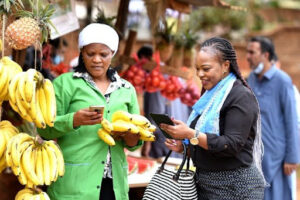In Africa, the spotlight is on the evolution of digital payments as the beacon for the post-COVID-19 pandemic economic recovery. How do these digital payments support job creation, promote efficiency in service delivery, and facilitate financial inclusion for the youth and women. Payments, especially retail payments, are integral to our daily lives. It, therefore, makes sense to challenge the status quo by developing fast and flexible means of digital payments.
Technological advances have brought to light the need to make financial services inclusive, useful and valuable. Inclusive systems unlock value for a stronger and more resilient economy, financial benefits for individuals and businesses, lower inequality, and access to other economic and social support systems. As public and private investment flow to the development of new financial infrastructure across the continent the needs of the poor must be not only considered but prioritised.

The history of digital financial services in Africa so far
Africa is in its second decade of the growth of digital financial services (DFS) – thanks to innovation and technological advancements. The expansion of these services was mainly driven by the high adoption of mobile money in the continent, enabling financial inclusion for hundreds of millions of previously excluded Africans, especially those from low-income households. As of 2021, Africa leads the global growth of DFS, experiencing a tenfold increase since 2012. The continent registered 621 million accounts, of which 184 million accounts are active.Financial inclusion provides tools and opportunities for building financial health, resilience ,and well being among our people while providing financial stability by deepened capital markets and improved transparency.
Over time, digital financial services have evolved from single offerings to product and services stacks. The increasing complexity of customer needs has influenced the evolution of DFS solutions across Africa. Providers now compete to introduce use cases that are relevant and useful to targeted market segments, fostering innovation.
The digital payments journey and milestones
Concentrated market power among DFS providers has triggered the current phase of the digital payments journey in Africa to be steered by a shift in regulation, intentional innovation, and a clear mission for inclusion.
A shift in regulation – key developments
The regulatory environment is dynamic, with a wide range of reforms to minimise barriers that hinder the development of digital payments systems and drive greater financial inclusion.
There has been an expansion of licensing payment regimes, predominantly led by markets where the traditional telco-led model was pioneered:
- Kenya: In 2021, parliament debated the legal separation of the mobile money business from the core telecommunications business of telcos.
- Tanzania: Legally separated mobile money business from the core telecommunications business of telcos in 2017
- Tunisia: In 2019, the Central Bank of Tunisia brought mobile money services under its regulatory purview.
- Nigeria: In 2020 and 2021, the Central Bank of Nigeria granted Approvals in Principle (AIP) to Payment Service Bank (PSB) applicants, which were telcos, with the optimism that these developments in Nigeria will stimulate the rapid adoption of mobile payments.
There have also been efforts to embed mobile money services within national payments infrastructures. A few countries have directly incorporated mobile money into national payments infrastructures through the development of national interoperability projects and payment switches.
Although the objective of regulation is to mitigate risks in the sector without stifling market innovation, some interventions inhibit the proliferation of digital payments. Specifically, taxation on digital transactions could reverse the adoption of digital payments, reduce financial inclusion gains and undermine the robustness of payments infrastructure. The other emerging regulatory challenge is the introduction of restrictions on the flow of data across borders. While national data privacy concerns are legitimate, data localization laws often lack contextualization for financial services, increasing infrastructure costs for providers, restricting new entrants, and increasing costs for consumers.
Innovation in payments
Below we consider innovations in digital payments in three stages following the growth and prevalence of low-value – high-volume transactions.
The first stage (circa 2006 – 2010) spread in parallel with telco companies’ mobile money distribution capabilities – leveraging the advantages of adapting fast-moving consumer good distribution metrics to disrupt the financial services by developing basic innovative digital banking and payment solutions. As telcos built agents networks, individuals were able to top-up, transfer minutes as value, and pay bills via assisted transactions.
The second stage (circa 2010 – 2018) involved more agile fintech entities leveraging mobile payment systems, among other early advancements, to develop products and services that targeted the bottom of the pyramid and focused on the financially excluded population. Here, providers led by and in partnership with fintech entities adopted innovative approaches to risk assessment, distribution, payments, administration, and product design to achieve the scale required to service the mass market. The key enabler in this stage was the rapid adoption of mobile phones in Africa and providers recognizing the dominance of feature phones for individuals to self-serve their accounts via core mobile technology like USSD short-codes.
In the current third stage (from around 2018), there is the convergence and aggregation of financial services prompted by the creation of platforms as marketplaces for providers to offer a host of products and services to an aggregated customer base, enabled by partnerships and increased interoperability.
Despite these advancements, a significant proportion (57%) of African adults remain formally financially excluded, due to persistent barriers such as low relevance of solutions offered, and unaffordability of solutions, access barriers, safety and security concerns, among others. Even among the population with accounts usage lags significantly because of the limited digital ecosystems.
A clearer mission for inclusion – making financial services inclusive, useful, and valuable to all.
Inclusive financial systems facilitate economic growth and lessen inequality in offering financial services. However, in the early days of the market evolution in Africa, the role and power of inclusive financial systems were overlooked. During the last few years, African governments and multinationals have moved towards a consensus that a well-functioning and inclusive financial system facilitates commerce, economic growth, financial stability, and security for all individuals, businesses, and communities. A leading component of inclusive financial systems is the retail financial infrastructure, which includes underlying instruments such as payments, credit and savings, among others.
Large swaths of the African population originating from low- or no-income households can no longer be left out of the financial infrastructure. Their spending drives demand-side economic growth, and the small and micro-businesses create supply-side multiplier effects. Providing them tools to enable safe liquidity creates a more resilient economy, lowers inequality and provides access to other economic and social support systems. Therefore, the case for instant and inclusive payments systems for developing inclusive financial systems has been recognized as an underlying component that facilitates the actualization of the above benefits.
What are instant payments today?
Remember when it took days or weeks to move money from one place to another through friends or family travelling, or the bus driver with lots of risks! Now that mobile money is so prevalent in sub-Saharan Africa, one can send and receive digital funds in real-time. High-income Africans are now in the generation of immediacy where one can text, tap, wave, and swipe to pay and get paid. Ubiquity and seamlessness are the new norms in payments. Yet, speed is not the only factor in instant payments. Uniquely, they must have the convenience of 24/7/365 and the irrevocability of the transaction (the receiver has immediate access to the funds and they cannot be pulled back without consent).
Instant and Inclusive Payment Systems, “IIPS are characterised by interoperability and continuous, real-time availability, ensuring that, in addition to being able to pay anyone, customers can make payments quickly and at any time.” At AfricaNenda, we believe that scaling up IIPS can play a pivotal role in accelerating universal access to financial services for many financially excluded adults in Africa. We also believe that for IPS to be the steppingstone on the financial inclusion journey of the poor, they need to be designed with clarity on the needs of the poor, women , and other disadvantaged groups. The Level One Project design principles embrace this approach. Instant and Inclusive Payment Systems (IIPS) aligned with Level One Principles promote interoperable open-loop systems, real-time push payments, pro-poor governance practices, and shared investment in core functions such as fraud detection. IIPS also operates on a not-for-loss or cost-recovery plus investment basis where payments are priced as a utility.
A new day for the underserved and the poor?
Instant Payment Systems (IPS) create the fundamental rails upon which digital financial service providers can build customer-centric, value-added services. They tend to bring inclusion to the last mile through mobile phones. The GSMA estimates that mobile subscribers in Sub-Saharan Africa will reach 615 million by 2025, in other words, 50% of the region’s population. Turning those mobile phones into the default instant payments devices could rapidly catalyse the cash to digital conversion for the financially excluded. Mobile money has already shown its ability to drive the financial inclusion of the poor in Africa. Impressively after ten years of life, it continues to have double-digit growth. Based on GSMA dataThere was a 17% increase from last year in mobile money accounts.
The competition for IIPS is cash. The new systems need to transcend the experience and convenience of cash. Interoperability of digital payments systems at the national level offers the alternative to pay and get paid anywhere and at any time. “These features replicate the liquidity of cash while providing users with additional security and a digital footprint that accelerates formal financial inclusion and transaction safety.” At the cross border and pan-African levels, interoperable payments systems have out-sized potential in facilitating low-value cross border trade and remittance payments. Instant payments systems are growing in Africa, national schemes, and regional ones alike. Schemes, like the Ghana Interbank Payment and Settlement Systems Limited (GhIPSS) and the SADC Transaction Cleared on Instant Basis (TCIB), are altering the payment landscape on the continent and introducing new dynamics. the ‘”Ghana Quick Response code” ( GhQR code) is an interoperable solution that allows customers to either send or receive payments by scanning a QR code on a smartphone or by dialling a USSD code provided by a payments service provider“ “. Today, TCIB is enabling cross border low-value instant payments across the SADC region.
How might we move forward to scale up IIPS across Africa?
The development of IIPS, whether led by central banks, private sector associations, or public-private partnerships remains a complex endeavour. AfricaNenda works with all these stakeholders, to address bottlenecks around pre-project support and institutional capacity building that are currently restricting the scale-up of instant and inclusive payment systems in Africa.
We are preparing a report on the State of Instant and Inclusive Payments Systems (SIIPS) in Africa for an October 2022 launch. The annual report will build a repository of data and insights on IIPS across the continent, highlighting barriers and growth opportunities We look forward to sharing the report with private and public payments stakeholders and accelerating IIPS that benefit all Africans and drive the continent’s development.




